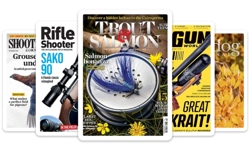One of our interviewers recently collared a female shopper outside a supermarket. The woman had a copy of Marie Claire in her trolley. When asked why she had bought it, she said: "I felt like a treat. It looked good. I just got it off the shelf."
Now that is hardly a blinding insight into consumer purchasing behaviour; not because the woman was stupid or inarticulate, but because buying a magazine is often very "back of mind" and apparently impulsive. Yet this particular purchase was actually much more complex than it originally appeared and was the result of a whole jigsaw of jumbled feelings and motives. Laying out that jigsaw is what good consumer purchasing research is all about.
Browsing process
The woman agreed to undergo a more extensive interview back in the supermarket where we watched some video footage of the time she had spent at the magazine racking: over three minutes in total – much longer than she herself had estimated. In those three minutes she browsed a number of titles, looked at cover lines, scanned contents pages, skimmed some of the features and prodded a few covermounts. Clearly, a series of value judgements was being made very quickly during this browsing process.
The most striking factor from the video was how purposeful her approach to the racking had been. She seemed to know precisely where she was going and which title she was going to buy. Yet when questioned, it was clear that this was not the case. Her thought process, after much teasing out of her, seemed to be:
* I have some spare, "me time" coming up. I want a glossy magazine to curl up with.
* I like Marie Claire, but I’m not sure whether I want it this time. So let’s look at the glossy magazine section.
* She found Marie Claire first, but scanned the covers of everything else around it to see what was eye-catching. The visual elements of the covers, including covermounts, helped to narrow the choice in seconds.
* The coverlines then established more clearly the relevance of each particular magazine to her. It was the more quirky ones which appealed to her.
* A mental shortlist was then created, with the copies being picked up for a quick flick through. This was not possible with a number of titles as some covermounts were bagged – a controversial area which provoked a long discussion!
* In the end, her final choice was Marie Claire. As this was her most regularly bought magazine, the first assumption (including the shopper’s own) could have been that this was a clear, pre-planned decision, when in fact the selection process was actually much more open-ended and unpredictable.
Picking apart this process sparked discussion about a range of other issues: the negatives of covermounts which do not hit the mark, the complex role of value in the decision-making process (while few consumers can accurately remember the cover price of a magazine which they have just bought, they do have very clear price bands in mind for different kinds of magazine and do make strong value-for-money judgements, even if those judgements may be very unstructured), if the magazines she had wanted to look at had not been available, what would she have done?.... Gone to another shop, (which would have been a WHSmith incidentally) or simply chosen from the available range? And so on.
Her anchor point
As an interesting footnote, this was the first time that this shopper had been to this particular supermarket and she was not sure of the shelf layout. She had not even noticed the interest category signs that the supermarket had placed over the shelves - when asked about them she found them to be too broad and generic to be of any use anyway. What she had actually done was to look for Cosmopolitan, which had multiple facings on this visit, as her anchor point and then had found Marie Claire close by. She no longer read Cosmo and laughed when we suggested that she might: "That’s all sex and jobs and sex. I left all that behind years ago." Yet she still used it to find her way around the magazine racking.
Linked to this, our shopper was very aware of publisher-driven, "on-pack" promotions such as covermounts and price-cuts, but the retailer’s own in-store mechanics simply had not registered on her radar in a magazine shopping environment that she reckoned was pretty dull and lacklustre. "It does the job", but not much more.
Purchasing model
This kind of discussion is not earth-shattering, but it highlights the reality of magazine buying on the shop floor where consumers often act in very different ways from what we sitting in publishing offices expect. By piecing together individual insights such as these, Brandlab has created a magazine purchasing model which is centred on two key repertoires.
The first is the Magazine Repertoire. Most consumers have a range of around 11 magazines that they buy from on a regular basis. Understanding the make-up of that repertoire is central to the whole marketing process. There are often some surprises as to the combinations of titles that people buy: combinations that go way beyond the simple list of competing titles that publishers tend to concentrate on. Focusing on your direct competitor may actually be very misleading and myopic. It also ultimately results in marketing activity which can be overly biased to simple brand-switching.
The second is the Channel Repertoire. The modern magazine buyer is increasingly using a mix of purchase channels, both retail and subscription, supplemented by doses of online. Understanding why the same consumer can subscribe to a magazine on one occasion and buy that same magazine via retail on another occasion is, again, central to shaping a coherent circulation strategy. And where does the magazine website fit into this "mixed economy" of magazine purchasing?......A key question in the current publishing environment.
Shopping patterns
In terms of shopping patterns, the average magazine consumer has a repertoire of three shops from which they regularly buy their magazines; typically a mix of a supermarket, a high street newsagent (which generally means WHSmith) and a local independent retailer. Petrol stations, convenience stores and travel points are supplementary "top-up" shops.
No single shop satisfies all their magazine needs. Which shop they use on any particular occasion is determined by a whole range of factors, including what the "shopping mission" is. Is it to complete the regular food shop? Is it a town centre shop for other goods? Is it a quick in-and-out visit or a more leisurely and pleasurable browse? Is it killing time waiting for a friend or before a journey? And so on.
Another key statistic is that the average magazine buyer visits retailers that sell magazines 15 times per month, but only buys on three occasions. A number of different things could be happening on each shop visit. The shopper might simply not have the time to read a magazine at the moment (a strong theme from all our research is that magazines are for immediate consumption; the "storage mentality" that often operates in other FMCG categories does not work here), but they might still want to browse to review their repertoire and to keep up-to-date, so that they are ready for their purchase when it comes on another occasion.
It is at the magazine racks that all the accumulated brand perceptions and prejudices bubble up in a torrent of very fast and often subconscious value judgements: the perceived worth of the covermount, the image conveyed by the cover, the relevance of the coverlines, the layout and ease of navigation within the magazine.
Behind all these product-related issues lie a number of more operational, retailer-related factors. Is the magazine I want actually available? What do I do if it isn’t? Are the shelves really messy and off-putting? Is there space to browse? Are the staff helpful? Are the staff hovering and deterring from browsing?
Applying the lessons
So what does all this mean in practice? What the body of in-store research does suggest is that there must be an industry opportunity to grow the whole magazine category through more exciting and structured retail displays. More "retail theatre" around the magazine area, seasonal theming, stronger highlighting of new launches, cross-promotions with other product areas in-store: these are all elements which could be developed further in the consumer’s mind.
Yet as the purchasing dynamics can vary significantly from title to title and from sector to sector, a structured understanding of how and why consumers buy can give individual publishers real opportunities to grow their share more profitably.
* It will determine where to spend money in order to increase simple awareness and brand image with the consumer.
* It will shape where to direct the trade marketing budget to best effect, focusing on retailers where in-store spend can make a measurable difference.
* It will help to create covers and coverlines that will really appeal to the consumer.
* It will refine the editorial profile and how that editorial is presented.
* It will shape the "value policy", balancing the cover price against the perceived worth of the product.
* It will also help build links with the key retail accounts who are keen for new insights as to how to drive more revenue from their magazine space.
The aim of most modern in-store research is to make the link between reading and shopping rather than regard them as two completely different processes. Only when a publisher understands this link can he really start to influence sales and to build a long-term and stable business in an increasingly volatile retail marketplace.
FEATURE
Why did they do that? Understanding consumer purchasing
The prospective magazine buyer is standing in front of the rack, browsing. It’s make or break. What can you do to ensure that it is your title that ends up in the shopping basket and not your rivals’. Having some idea of what is going on inside the shopper’s head is critical to maximising your newsstand potential. Brandlab’s Jim Bilton surveys the in-store battleground.










